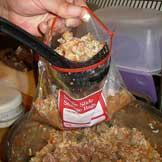
A couple of weeks ago in response to my post about the new AAFCO (Association of American Feed Control Officials) labeling requirement to include calorie counts on all pet foods, Tom Collins asked for “guidelines for recommended daily calorie intake for various pets, age groups, lifestyles, etc.” This isn’t as easy as you might think, but I can provide some guidelines that can help. First a caveat or two.
Even when taking into account a dog’s lifestyle, age, activity level, etc., it is impossible to mathematically determine exactly how many calories (or kilocalories as they are called in veterinary medicine) a pet needs. Variations in metabolic rates can alter this figure by as much as 20 percent either way. Therefore, any number that you come up with needs to be viewed as an estimate only. Feed that number of calories, monitor the dog’s weight, body condition, and overall wellbeing, and adjust accordingly.
Include your veterinarian in this conversation, particularly if your dog has any health problems or special dietary needs. Nutrition, including determining how many calories a pet should be taking in, is not a one-size-fits-all endeavor. Calorie “calculators” or tables cannot take into account what might make an animal’s situation unique.
The standard steps used by veterinarians to determine a dog’s caloric needs (otherwise known as their maintenance energy requirements) are as follows:
- Divide a dog’s body weight in pounds by 2.2 to convert to kilograms (kg)
- Resting Energy Requirement (RER) = 70 (body weight in kg)^0.75
- Maintenance Energy Requirement (MER) = appropriate multiplier x RER
Commonly Used Multipliers:
|
typical neutered pet |
1.6 |
|
typical intact pet |
1.8 |
|
weight loss |
1 |
|
weight gain |
1.7 |
|
light work |
2 |
|
moderate work |
3 |
|
heavy work |
6 |
|
growth (less than 4 months old) |
3 |
|
growth (more than 4 months old) |
2 |
Here’s what the calculations look like for a neutered pet dog weighing 45 pounds that is at his or her ideal weight.
- 45 lbs / 2.2 = 20.5 kg
- 70 x 20.5^0.75 = 674 kcal/day
- 1.6 x 672 = 1075 kcal/day
Remember, this is just a ball park figure. This pet’s actual needs may actually be anywhere between 860 kcal/day and 1,290 kcal/day.
If your eyes have glazed over with all this math, you can use tables like the ones put together by the World Small Animal Veterinary Association’s (WSAVA) Global Nutrition Committee instead. They are available for both dogs and cats, but are only designed to be used for “average” healthy adults that are in ideal body condition.
But guess what? The value in the WSAVA dog table for our hypothetical 45 pound dog is roughly 805 kcal, which doesn’t even fall within the range I mentioned above. See what I mean when I say that these references and formulas can only be thought of as “ball park” figures?

Dr. Jennifer Coates
Note: The ^ math symbol designates the following number as being an exponent of the preceding number.
See Also:
Image: Cheryl / Flickr
Last reviewed on September 16, 2015









